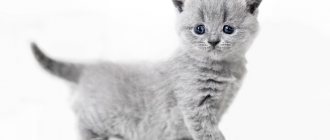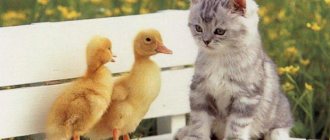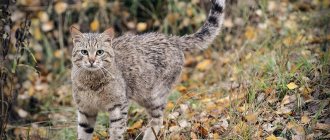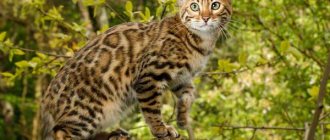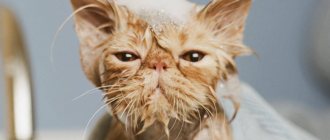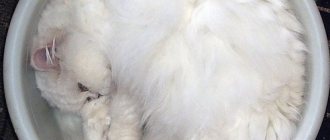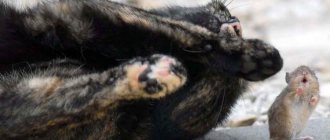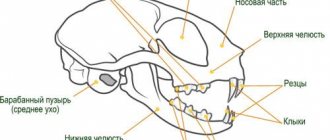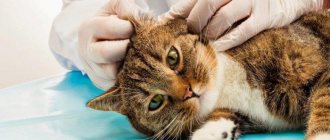The Highlander is an American experimental cat breed that was developed by crossing the Desert Lynx and the Jungle Curl. Distinctive features of the Highlander: a short tail, curled ears and a tabby pattern. By nature, this is an ordinary domestic cat, somewhat independent, affectionate and playful. Other names for the breed: Highlander shorthair or Highland Lynx.
- 7.1 Video about the Highlander cat breed (HighlandLinks):
Brief history of the breed
Work on breeding Highlanders began in 1993, when breeders decided to improve the already existing Desert Lynx cat variety. To make their ears curled, experts used representatives of the new hybrid breed Jungle Curl (obtained by crossing Bengals, Serengeti, Egyptian Mau, American Curls, Chausie, etc.).
As a result, the breeders managed to fix the folded ears while maintaining the spotted lynx coloring. In May 2008, the Highlander cat breed received recognition from TICA, and from 2020 it can be exhibited in the Advanced new breed class.
Interesting Facts
Although the Highlanders do not have a rich history, many interesting things have been associated with them:
- The name of the breed Highland Lynx translates as “mountain lynx”. And in some sources these cats are referred to as shorthaired Highlanders.
- Due to the similar name, representatives of the breed are often confused with Highland Folds. But they are in no way related to the British and Scottish Longhairs.
- Formally, Highland Links can be considered hybrids. But the percentage of wild blood present in them is so small that it does not affect anything at all. Therefore, genetically, Highlanders are completely domestic cats that do not pose a threat to people.
Breed description, standards, appearance
Highlanders are muscular, compact cats with short tails and ears turned outward. Outwardly, they resemble strong and agile lynxes.
Dimensions and weight
Highlanders are fairly large cats with pronounced sexual dimorphism. The average weight of a female is 4.5-6.5 kg. The weight of a male Highland Lynx varies between 6.5-9 kg.
Anatomical characteristics
A typical Highlander cat should fit the following description:
- The head is triangular, with rounded cheekbones, a convex skull, a high forehead, a short blunt muzzle, pronounced whisker pads and a wide nose.
- The eyes are almond-shaped, medium-sized, slanting, widely set. The iris of the Highland Lynx can be green, orange or yellow.
- The ears are medium in size, with a wide base and flexible, curved back tips.
- The body is rectangular in shape, with a straight back, slightly raised croup and well-developed muscles.
- The limbs are of medium length, with rounded paws and pronounced knuckles.
- The tail is thick and short. Its length in Highland Links should not be less than 2.5 cm and longer than the hock joints.
On a note. The Highlander is one of the few breeds in which polydactyly is acceptable.
Color and coat type
The body of the Highland Lynx is covered with beautiful fur, the texture of which depends on the length and color. A cat of this breed is:
- shorthair - with a thick coat and dense undercoat;
- long-haired - with developed decorative hair, which, as it were, forms trousers and a frill.
According to the Highland Lynx breed standard, spotted, marbled or striped tabbies in any color combination are allowed.
On a note. The color of the Highlander's coat is determined by the tone of the undercoat. For example, if a cat's fur appears to be silver-black and her underpads are brown, then her color would be considered brown.
Possible breed defects
Exterior defects, the presence of which reduces the breeding value of the Highland Links:
- weak bones;
- the tail is shorter than 2.5 cm and longer than the hocks;
- ears are bent more than 90 degrees.
Description
The British Longhair cat has thick fur that is so plush that when you stroke it, it feels like a toy. These are medium-sized cats, with a muscular body, a wide chest, short legs and a short and thick tail.
If the short-haired breed has a massive, muscular body, then the long-haired breed hides it behind thick hair.
On the wide, round head there is a frozen smile, the feeling of which is created by plump cheeks and upturned corners of the mouth. Plus big, bright eyes and the impression that this is the same Cheshire cat in front of you.
Males weigh 5.5-7 kg, females 4-5 kg. Life expectancy is 12-15 years, sometimes up to 20.
The color is varied, it can be: black, white, red, cream, blue, chocolate, lilac. Add more spots and you get: tortoiseshell, tabby, bicolor, smoky, marbled, color point, blue point and others.
Character and temperament
The Highlander is a cat with a friendly and gentle disposition. He likes to be the center of everyone's attention, and he achieves this through funny pranks.
The curious Highland Lynx explores new places with the enthusiasm of a true explorer, but does not go on a “race” through curtains and closets.
On a note. Highlanders are not particularly talkative. To express emotions, representatives of the breed prefer to use tail wagging or an ingratiating look into the eyes of their owners.
The friendly nature of Highlanders allows them to easily find a common language with children. Non-jealous and calm cats never respond with aggression to childish pranks. Highland Links also easily get along with other pets and get along peacefully with all animals, including rodents, reptiles and birds.
Character and behavior
Highlanders are large cats with a gentle disposition. Affectionate, playful and moderately independent. They become strongly attached to family members and always try to be in the center of events. They get along well with other pets, especially those they grew up with and provided they have been well socialized. They often calmly share territory with ferrets, birds, rabbits, and reptiles.
The owners note that Highlanders are very smart, they are easy to train and raise, quickly remember the rules of behavior in the house, and have no problems toilet training and walking on a leash. They are not phlegmatic and will not sleep all day long, waiting for the owner to come. But they are not the kind of climbing cats that tear down curtains and swing chandeliers. Some members of the breed prefer not to be handled, while others are more independent and do not like to lie on their laps. They get along well with children and are almost never aggressive; they prefer to hide from unnecessary attention. They are not very talkative cats, but they are able to very clearly express their emotions in other ways, including wagging their short tail.
How to choose the right kitten
The Highlander is an expensive and rare breed of cat. Leading breeders specializing in breeding such animals live in the United States. Therefore, you will most likely have to choose a Highland Lynx kitten in absentia. In this case, it is advisable to focus on the following criteria:
- availability of pedigree and veterinary passport;
- conditions of detention;
- behavioral characteristics;
- compliance with the breed standard;
- health status.
On a note. Highlander kittens are born straight-eared. As they grow, the tips of their ears curl back.
Breed cost
The British Longhair cat is a popular breed, so finding a cattery or breeder is not difficult. Individuals on sales sites should be treated more closely. It is difficult to judge the purebred cat breed from a photograph; it is better to see the kitten and its parents in person. Another equally important question is the cost of the kitten. The price depends on the following factors:
- Floor. Cats are a little more expensive than female cats.
- Class (pet, brit, show, ascending price respectively).
- Parents' pedigree.
- Color.
- Prestige of the nursery, breeder from whom you plan to purchase.
The most expensive show-class kitten, intended for exhibitions and breeding, costs approximately $1,500-2,000. For a small price you can get a “defective” fluffy Briton who was born from short-haired parents with a recessive gene for long hair.
Choosing a kitten
It is recommended to purchase kittens at the age of 3-4 months. They are already accustomed to the tray, scratching post and vaccinated with the vaccine appropriate for their age.
Before buying a pet, you should decide for what purpose you are purchasing a British dog. For participation in exhibitions and breeding of the breed, the show class or breeding class with minor flaws in appearance is ideal. The Pet class is suitable as a stay-at-home pet, because... it is not allowed in exhibition events due to serious deviations from breed standards and is subject to mandatory castration, preventing breeding activities.
A kitten without papers is temptingly inexpensive, but there are no guarantees about its purebred. Only a specialist can name the class, but you can determine the purebredness of a kitten yourself by the characteristics characteristic of British cats:
- Round head with a wide forehead.
- Chubby cheeks.
- Small rounded ears.
- Medium-sized nose with no visible transition in the eye area.
- Fluffy elongated coat.
You can verify the purebred in another way - please provide the relevant documents: birth certificate, pedigree, veterinary passport and others. The third option is to look at both or one of the baby’s parents. The health of the cat is an important criterion for choosing a pet:
- Active, curious.
- Neat appearance with shiny coat.
- Clear, clean eyes without discharge.
- Skin without damage.
- Clean ears without plaque.
Care and maintenance
Unpretentious Highland Links are able to quickly adapt to any conditions. They live in apartments and private houses without any problems. Caring for Highlanders includes a number of standard procedures:
- The eyes and ears of cats are regularly examined for the presence of nonspecific discharge and wiped with cotton pads soaked in alcohol-free products.
- Highlanders' claws grow very quickly and break off. Therefore, they are systematically shortened with a nail cutter so as not to affect the blood vessels. And to prevent cats from tearing wallpaper and upholstered furniture, they are provided with scratching posts.
- Highlanders' teeth are brushed several times a week with a non-foaming paste using a special silicone brush or soft brush.
- Cats of this breed are bathed 3-4 times a year or as needed. Bath procedures are carried out in warm rooms where there are no drafts. And for washing they use special shampoos.
- Long-haired Highland Links require careful grooming. They are systematically combed out with a slicker brush or a brush with soft bristles. The hair of shorthaired Highlanders is treated several times a week with a special glove.
Maintenance and care
The Highlander, although it has an exotic appearance, does not require special conditions or complex care. He will be happy in the apartment if he has a play set and a couple of toys. In a private home, he will be happy to go outside and participate in battles for the cat.
Care comes down to standard procedures. The fur is combed periodically. Complete wash as needed. Claws are trimmed as they grow. Make sure ears and eyes are dry and clean.
Most Highlanders do not need any special diets and thrive on good standard food. Some cats need slightly more protein; their diet is supplemented with natural meat. Vitamins and microelements are given as prescribed by a veterinarian or recommended by a breeder.
Feeding the cat
Highlanders are active cats with an excellent appetite. They happily eat both industrial and natural food. Therefore, when choosing a diet, you can be guided by your own preferences.
With an industrial type of nutrition, Highland Links buy premium or super-premium food with a complete, well-balanced composition. The following brands of drying are perfect for cats of this breed:
- Acana;
- Bosch;
- Brit Care;
- Pronature.
Important! Highlanders, whose diet is based on dry food, should have free access to fresh drinking water.
With a natural type of nutrition, the menu of cats of this breed should be dominated by protein foods in the form of raw chicken, turkey, lean beef or rabbit meat. Several times a week, meat can be replaced with boiled offal and ocean fish. It is also recommended to include porridge, quail eggs, fermented milk products and vegetables in the diet of Highland Links.
To maintain normal functioning of the gastrointestinal tract, fatty meat, river fish, bones, potatoes, milk, sausages, pickles, confectionery and any food from the owner's table are excluded from the menu of these cats.
On a note. With a natural diet, mineral supplements are introduced into the Highlanders’ diet twice a year, which are selected after consultation with a veterinarian.
Education and physical activity
Highland Lynx cats are energetic and temperamental cats. To maintain muscle tone and good physical shape, they need a lot of exercise. If desired, Highlanders can be easily trained to walk on a harness. If this is not possible, they will set up a sports corner for the cat at home and buy several different toys.
Highland Links are endowed with high intelligence and excellent memory. Despite their wild appearance and penchant for mischief, cats of this breed are easy to train and, like dogs, remember simple commands.
On a note. In order not to spoil the pet and prevent undesirable behavior from becoming established, the little Highlander is taught order from the very first days.
Character of the breed
Kittens are playful and inquisitive, which cannot be said about adults: older Britons will prefer the sofa to any interesting game.
Highlanders are difficult to piss off. These are very calm and balanced cats. They love solitude and rarely need to communicate with members of their household. Non-conflict: calm towards other pets in the house.
Cats are smart by nature, and therefore raising them and teaching them order will not take much time. The restraint of this breed of cats is surprising: even with severe hunger, the cat will not bother you with meows, begging for food, but will simply sit by an empty bowl.
Cats have a cool calmness. They are humble about crowds when participating in exhibitions. A trip to the veterinarian will also be accepted with equanimity.
They are affectionate, but prefer to sit next to their owner. They are not given in hand. They can withstand the attention of children, although lifting a 5-7 kilogram carcass will be very problematic for a child.
Health and susceptibility to disease
Highlanders are strong and hardy cats with good heredity. Under favorable conditions, they live up to 14-16 years.
Despite good immunity, representatives of the breed are prone to the following diseases:
- obesity;
- allergy;
- hypertrophic cardiomyopathy.
In addition to specific pathologies, Highland Links are prone to standard feline infections. Therefore, they are required to undergo routine preventive vaccination and antiparasitic treatment.
Pros and cons of the breed
Since Highland Links are not cheap, before buying a kitten you should analyze all the advantages and disadvantages of this breed:
| pros | Minuses |
| Cute appearance | The high cost of kittens |
| Low maintenance | Small number of nurseries |
| High intelligence |
Highlanders are beautiful short-tailed cats with original colors and unusual ears turned back. Their wild appearance is successfully complemented by a friendly and sociable disposition, which makes them an object of interest for many exotic lovers.
